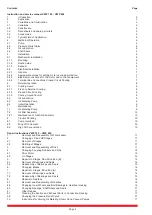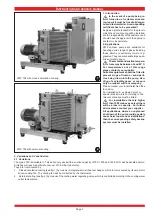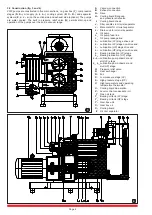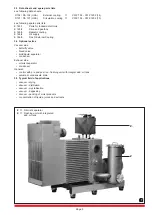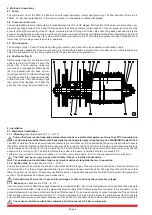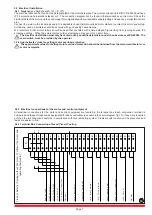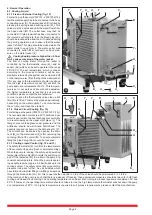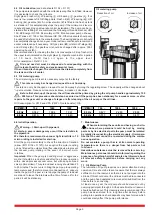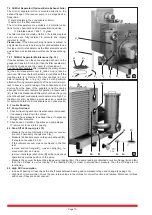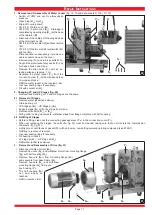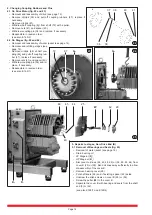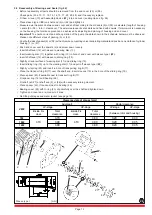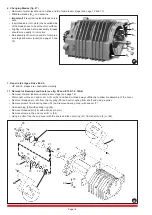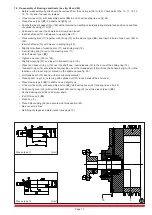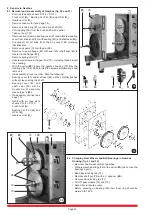
Page 9
6.2 Oil Lubrication (see data sheets D 134 + D 137)
The pumps are despatched with the oil tanks (except fresh oil) filled. However
it is advisable to check the oil levels.
Sight glass: Fresh oil (I), LP-bearing (I
1
), HP-bearing (I
2
), gearbox (I
3
). If oil
level is low, please refill. Oil filling points: Fresh oil (H), LP-bearing (H
1
), HP-
bearing (H
2
), gearbox (H
3
). An oil level switch (V) is fitted in the fresh oil tank
as standard. This automatically stops the pump if the minimum oil level is
reached (depending on actual site control installation). The pump can be re-
started after refilling. We recommend the following oil brands: Bechem VBL
100, BP Energol RC 100, Esso rotary oil 100, Mobil vacuum pump oil heavy,
Shell Tellus oil C 100 or Aral Motanol HK 100. Other lubricants should only
be used after reference to the manufacturer. The bearing and gear oil should
be completely changed once a year. Under extrem conditions we recommend
earlier maintenance if necessary. Oil type plate (M), oil drain LP-stage (K
1
)
and HP-stage (K
2
). The gearbox oil should be changed after approx. 3000
operating hours (K
3
).
Recommendations for cheking the fresh oil consumption: Fill up fresh oil to
the upper level indicated on the sight glass (I). Operate machine for a period
of 10 hours. Refill fresh oil again to the upper level.
Oil consumption = Refill / 10 hr
Old and used oil must be disposed of corresponding with the
relevant health, safety and environmental laws.
If the oil brand is changed. The old oil must be drained completely from
the tank and the oil cooler.
6.3 Oil metering pump
The oil metering pump is set to necessary output at the factory.
This rate can only be changed on request to our Company.
This rate can only be changed on request to our Company by turning the regulating screw. The capacity will be changed about
1
/
3
per revolution. Reduce oil counter-clockwise, increase oil clockwise.
Before first start-up of the pump, the oil flow should be primed by giving the oil pump handle approximately 150
- 200 turns. This procedure should also be carried out if the pump has been stationary for a week or more, or after
repairs to the gear unit or change of stages or after cleaning of the oil pump or the oil lines.
Oil Consumption for VWZ and VPA (VWZ + Roots booster): l / h
6.4 Initial Operation
Warning –> Start-up with pipework
At start-up, severe damage may occur if there is debris in
the pipework.
We therefore recommend a vacuum tight inlet filter of 5
micron rating is installed for start-up.
Start the pump momentarily to check the direction of rotation
(arrow (O
➞
D 134 + D 137)). As an option the motor coupling
can be fitted with a unidirectional free-wheel device to prevent
the vacuum pump rotating in the event of incorrect motor
rotations.
Important: When the pump is handling moist or aggressive
media, it should be run before and after the process operation
with a closed process vacuum valve, but with an open bleed
valve (optional item). This pre and post running should take 20
to 30 minutes. The pre run is to bring the pump up to operating
temperature and therefore prevent condensation of vapours
inside the pump. The post run is to purge the pump of residual
media and to leave the internals with a film of clean oil for the
period it will be stationary.
Reduction of oil
Increase of oil
Oil metering pump
VWZ
702
1002
1202
50 Hz
0.342
1.094
1.367
60 Hz
0.410
1.312
1.640
VPA
702. ...
1002. ...
1202. ...
50 Hz
0.427
2.280
2.848
60 Hz
0.513
2.736
3.417
7. Maintenance
When maintaining these units and having such situ-
ations where personnel could be hurt by moving
parts or by live electrical parts the pump must be isolated
by totally disconnecting the electrical supply. It is impera-
tive that the unit cannot be re-started during the mainte-
nance operation.
Do not maintain a pump that is at its normal operating
temperature as there is a danger from hot parts or hot
lubricant.
Hazardous substances must be removed before serving.
Maintenance personnel should be informed regarding the
presence of anything harmful and also be informed about
all relevant safety regulations before carrying out any
work.
7.1 Oil Metering Pump
The lubrication oil pump requires no special attention during
operation. Care should be taken to ensure that there is always
sufficient oil in the reservoir so that air is not pumped into the
oil lines. If this should occur the oil lines must be dis-connected
and the pump hand operated to remove all air bubbles from the
lines before re-connecting.
At least once a year the oil pump should be cleaned out by
pumping petroleum through it. At the same time the oil reservoir
should be flushed out. This cleaning is also recommended if the
pump has been stored for a long time after delivery before
putting into operation as hard deposits may have formed which
could adversely affect the pump performance.


